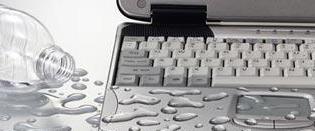Besides a battery fire, a liquid spill on a laptop is one of the more dangerous problems you can have.
 Because your laptop is an electrically powered device, the possibility of a severe shock should make you extremely cautious in taking the first few steps to save the notebook. Some laptops have spill resistant keyboards or thin metal shields under the keyboards which will deflect a minor spill from doing serious harm to the system, but the steps you take in response can make the difference in how well you may recover. Keep in mind that you are at risk handling a wet laptop that is plugged in with the ac adapter. Having expressed the need for extreme care here, follow the proceedure below to save your laptop or at least the files on your notebook. Recovering from a spill on a laptop is a two step process; the first step being to safely disconnect power, and secondly to dry it out so it can be made useable again. Because your laptop is an electrically powered device, the possibility of a severe shock should make you extremely cautious in taking the first few steps to save the notebook. Some laptops have spill resistant keyboards or thin metal shields under the keyboards which will deflect a minor spill from doing serious harm to the system, but the steps you take in response can make the difference in how well you may recover. Keep in mind that you are at risk handling a wet laptop that is plugged in with the ac adapter. Having expressed the need for extreme care here, follow the proceedure below to save your laptop or at least the files on your notebook. Recovering from a spill on a laptop is a two step process; the first step being to safely disconnect power, and secondly to dry it out so it can be made useable again.
Power should be discontinued as safely and quickly as possible by;
- Shutting down the system with a nonconductive object to breifly press the power switch (a common power setting in Windows will cause the system to quickly shut down).
- If pressing the button breifly doesn’t work use the same nonconductive object to hold the power switch 4 or more seconds which will cause the system to shut down.
- Disconnect the ac adapter from the 110v connection prefferably by shutting off the associated breaker, uninterruptible power supply (battery backup), or power strip.
- The ac adapter can also have power disconnected by unplugging it from the wall or the power cord. It will be necessary to unplug from a battery backup also. A battery backup is also a 110v power source.
- Many ac adapters have a power cord which can be disconnected from them, but take care that none of these devices are wet.
- Remove the battery as soon as the laptop is off and safely disconnected from the ac adapter. If you’ve never removed your battery before, look for a sliding latch on the bottom (sometimes 2) that will eject the battery. Some laptops have a battery compartment at one end of the handrest that can be opened and the battery can be carefully removed. Handle the battery carefully to avoid a short from any residual liquid.
- Remove any secondary battery also, which may be installed in some laptops.
After power has been removed, follow this process for drying out the laptop;
- Quickly blot up what moisture you can with a soft cloth, like a towel. Don’t rub as you may spread some moisture around.
- Fold the screen forward to somewhere between 30 and 45 degrees with the base, but don’t close the lid.
- Stand on one side on absorbant material such as a newspaper; preferrably the side with the CD/DVD since there will often be less circuitry on that side. This will drain any liquid inside the laptop to one side. Leave the laptop in this position for as long as you can. If the newspaper has gotten very wet, you may want to change it out after an hour so any additional liquid has somewhere to go.
- Disconnect usb devices, ejectable drives, or inserted cards and dry these devices separately.
- Change position so that the hinged edge of the laptop is facing up (like the letter A). Any residual moisture on the edge that had been facing down can now be dried off. Again, the laptop should be left to drain and dry for several hours.
- Resist the temptation to try restarting your laptop without having it professionally serviced. After avoiding a disaster by following the steps outlined above, you may cause the problem you sought to prevent by not getting residual moisture removed. Liquids other than water can also leave residue or cause corrosion which may be mitigated disassembly and proper cleaning.
- Saving data may be more important than making the laptop run, and file recovery may well be possible after a spill.
|